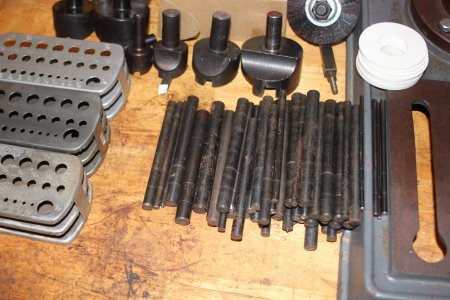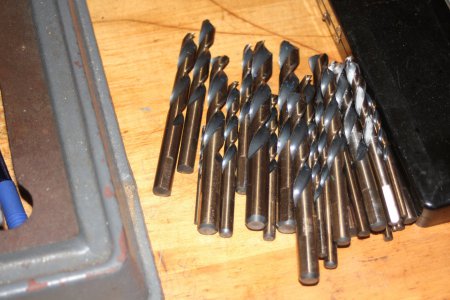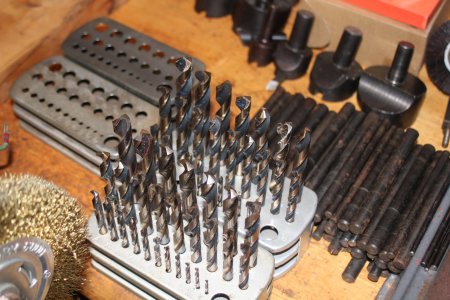-
Welcome back Guest! Did you know you can mentor other members here at H-M? If not, please check out our Relaunch of Hobby Machinist Mentoring Program!
You are using an out of date browser. It may not display this or other websites correctly.
You should upgrade or use an alternative browser.
You should upgrade or use an alternative browser.
POTD- PROJECT OF THE DAY: What Did You Make In Your Shop Today?
- Thread starter wachuko
- Start date
@BGHansen
I can't believe I read the whole thing!
I wondered about the inverter mode choices. Do you switch from 'self supply' to a mode that keeps the battery at max during cold weather? As I understand it, using the 'Self Supply' mode could potentially leave you short of full battery backup if there was an unexpected grid failure (ie; traffic accident takes out a pole?), regardless of weather. I would want to be sure the heater and water were working when the sun isn't shining.
I can't believe I read the whole thing!

I wondered about the inverter mode choices. Do you switch from 'self supply' to a mode that keeps the battery at max during cold weather? As I understand it, using the 'Self Supply' mode could potentially leave you short of full battery backup if there was an unexpected grid failure (ie; traffic accident takes out a pole?), regardless of weather. I would want to be sure the heater and water were working when the sun isn't shining.
We're on the same page and you are correct, "Self Supply" mode does not guarantee a charged battery. In fact, it guarantees a drained battery by morning as it is supplying the house after the sun goes down. We'll be switching between "Clean Backup" and "Self Supply" modes most likely in the winter. As you noted, the Generac battery is essentially an insurance policy that we have power during inclement weather. I consider grid power (when there's a lack of sun) paying the insurance premium to keep the battery charged. If we have a forecast of heavy snows, ice storms, or heavy winds, I'll switch it to "Priority Backup" which will charge the battery in about 1 1/2 hours. Then switch it back to "Clean Backup" mode which leaves the battery alone and supplies the house through the solar first, then grid if the solar isn't producing enough.I can't believe I read the whole thing!
I wondered about the inverter mode choices. Do you switch from 'self supply' to a mode that keeps the battery at max during cold weather? As I understand it, using the 'Self Supply' mode could potentially leave you short of full battery backup if there was an unexpected grid failure (ie; traffic accident takes out a pole?), regardless of weather. I would want to be sure the heater and water were working when the sun isn't shining.
The system status is available through an app hosted by Generac. It gives us the same status screen as the inverter plus some historic data. The biggest inconvenience for us is the inverter is mounted at our pole barn 50 yards from the house. The modes cannot (for the time being) be changed on-line by users, though we can call Generac and they can remotely switch modes. I have to walk down to the barn to change modes. Our system is a bit unique as our main panel is in the pole barn; a buried line supplies the house. The inverter needs to be at the main panel for back-feeding the panel to supply the house and send power back up the grid.
Bruce
Today i did my first tire puncture repair. Some time back i bought a tire machine because of the raised prices from tire places. Today i used it to remove the tire and repair it. I used an air grinder with a ball end to sand the place smooth and apply glue and pache, rolled it in and seal it with more glue. I only took couple of pictures because i got glue on my hands. The repair is holding, a marked and put the tire in the same spot to be balanced.






we may have to do more business together.Getting somewhat organized down the basement .
The doors are open 24-7 !we may have to do more business together.

Found the top notch inserts yet?
I do hope they forget about any follow up for the rest of the bill!!We're on the same page and you are correct, "Self Supply" mode does not guarantee a charged battery. In fact, it guarantees a drained battery by morning as it is supplying the house after the sun goes down. We'll be switching between "Clean Backup" and "Self Supply" modes most likely in the winter. As you noted, the Generac battery is essentially an insurance policy that we have power during inclement weather. I consider grid power (when there's a lack of sun) paying the insurance premium to keep the battery charged. If we have a forecast of heavy snows, ice storms, or heavy winds, I'll switch it to "Priority Backup" which will charge the battery in about 1 1/2 hours. Then switch it back to "Clean Backup" mode which leaves the battery alone and supplies the house through the solar first, then grid if the solar isn't producing enough.
The system status is available through an app hosted by Generac. It gives us the same status screen as the inverter plus some historic data. The biggest inconvenience for us is the inverter is mounted at our pole barn 50 yards from the house. The modes cannot (for the time being) be changed on-line by users, though we can call Generac and they can remotely switch modes. I have to walk down to the barn to change modes. Our system is a bit unique as our main panel is in the pole barn; a buried line supplies the house. The inverter needs to be at the main panel for back-feeding the panel to supply the house and send power back up the grid.
Bruce

We are still not done… system is up and running but they need to do install of bars to protect batteries, final inspection, and swap the meter…. But it is all working…


I will need to decide if I just add more panels once the workshop is done…
Last edited:
NICE! In Michigan we cannot be a "solar farm" and produce more than our historical bills over the last year. It seems fair to me as we currently pay for maintenance on the power lines through our normal electric bill from the power company. The less we use, the less we pay for the infrastructure maintenance. If we didn't draw anything off the grid, we'd pay nothing, but we'd get "paid" for sending power back up their lines. We should kick in something as we're using their lines. Most power companies in our area support what's called "net metering" or sending it back up the grid for credit, not cash. We earn $0.50 on the dollar for what we send which is credited to our bill.I will need to decide if I just add more panels once the workshop is done…
Bruce



